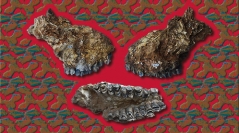

 Geodiversitas
44 (15) - Pages 437-470
Geodiversitas
44 (15) - Pages 437-470We herein re-discuss the systematics of the Late Miocene representatives of the most common but poorly documented Eurasian giraffid genus Palaeotragus on the occasion of the review and description of new samples from the Vallesian faunas of Northern Greece. Our results detect five Late Miocene Palaeotragus morphotypes, recognizing at least four species. The so called ‘small-sized palaeotrages’ are represented by the type species P. rouenii and the Chinese P. microdon, whereas the validity of P. pavlowae from Grebeniki (Ukraine) is doubted. ‘Large-sized palaeotrages’ are mainly represented by P. coelophrys (synonym of P. expectans, P. borissiaki, P. hoffstetteri, P. quadricornis, and probably P. moldavicus), a species that thrived in the peri- Black Sea territories during Vallesian and survived during Turolian in the Irano-Anatolian domain, likely by adopting a more robust appearance. Large palaeotrages from the Vallesian faunas of Pentalophos and Ravin de la Pluie (Axios Valley, Greece) are identidied as P. coelophrys with certain confidence. The Vallesian P. berislavicus from Berislav (Ukraine) has intermediate morphometric features between P. rouenii and P. coelophrys and it is, therefore, recognized as a most probably valid species. The latest Vallesian Nikiti-1 (Chalkidiki peninsula) large palaeotrage shares many morphometric features with P. berislavicus, suggesting that the species may have invaded Balkans by the end of Vallesian and possibly survived there until middle Turolian. The Late Miocene Palaeotragus asiaticus from Central Asia is a quite problematic species; it appears closely related to the Turolian equivalent P. cf. coelophrys from China and both may be linked to the older Berislav taxon.
Late Miocene, Palaeotragiinae, giraffes, Europe